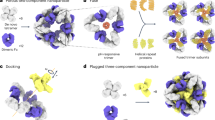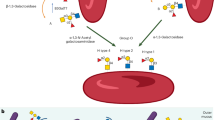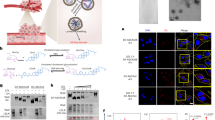Abstract
IN an attempt to clarify the mechanism of cell lysis under intense electric fields1–5, we have found that aqueous pores are introduced into human erthrocyte membranes when an isotonic suspension of red cells is exposed to an electric field of a few kV cm−1 for a duration in μS range. These pores are formed when the transmembrane potential induced by the externally applied field exceeds a critical value of 1 V. The effective radius of the pores is several Å, and can be varied by the adjustment of field intensity, field duration, and the ionic strength of the medium. The pores remain open at low temperatures but close completely on incubation at 37 °C. In a proper medium, the resealing of perforated cells takes place without haemolysis, allowing us to prepare erythrocytes (not ghosts) of altered intracellular composition. In particular, foreign molecules such as sucrose have successfully been incorporated into resealed erythrocytes, which were apparently intact at least in terms of cell volume, cell shape, glucose transport, and Na–K pump activity4. Thus we have suggested that erythrocytes loaded with a drug by this technique might serve as intravenous drug reservoirs which slowly release the drug molecules into the circulation. Here we demonstrate that erythrocytes loaded with sucrose survive in the circulation with a lifetime almost indistinguishable from that of normal cells, and that the sucrose remains entrapped within the cells. For drugs that slowly permeate the erythrocyte membranes, therefore, our technique offers a means of sustaining a low plasma level for a long period of time, and this could be advantageous in clinical and other situations.
This is a preview of subscription content, access via your institution
Access options
Subscribe to this journal
Receive 51 print issues and online access
$199.00 per year
only $3.90 per issue
Buy this article
- Purchase on Springer Link
- Instant access to full article PDF
Prices may be subject to local taxes which are calculated during checkout
Similar content being viewed by others
References
Tsong, T. Y. & Kingsley, E. J. biol. Chem. 250, 786–789 (1975).
Tsong, T. Y., Tsong, T. T., Kingsley, E. & Siliciano, R. Biophys. J. 16, 1091–1104 (1976).
Kinosita, K., Jr & Tsong, T. Y. Proc. natn. Acad. Sci. U.S.A. 74, 1923–1927 (1977).
Kinosita, K., Jr & Tsong, T. Y. Nature 268, 438–441 (1977).
Kinosita, K., Jr & Tsong, T. Y. Biochim. biophys. Acta. 471, 227–242 (1977).
Eilers, R. J. Am. J. clin. Path. 47, 212–214 (1967).
Kuharcik, A. M. & Forsthoefel, P. F. J. Morphol. 112, 13–19 (1963).
Russell, E. S., Neufeld, E. F. & Higgins, C. T. Proc. Soc. exp. Biol. Med. 78, 761–766 (1951).
Goodman, J. W. & Smith, L. H. Am. J. Physiol. 200, 764–770 (1961).
Wish, L., Furth, J. & Storey, R. H. Proc. Soc. exp. Biol. Med. 74, 644–648 (1950).
Gregoriadis, G. Nature 265, 407–411 (1977).
Whittam, R. Transport and Diffusion in Red Blood Cells (Edward Arnold, London, 1964).
Ihler, G. M., Glew, R. H. & Schnure, F. W. Proc. natn. Acad. Sci. U.S.A. 70, 2663–2666 (1973).
Updike, S. J., Wakamiya, R. T. & Lightfoot, E. N., Jr Science 193, 681–683 (1976).
Tyrrell, D. A. & Ryman, B. E. Biochem. Soc. Trans. 4, 677–680 (1976).
Zimmermann, U., Riemann, F. & Pilwat, G. Biochim. biophys. Acta 436, 460–474 (1976).
Gibaldi, M. & Perrier, D. Pharmacokinetics (Marcel Dekker, New York, 1975).
Author information
Authors and Affiliations
Rights and permissions
About this article
Cite this article
KINOSITA, K., TSONG, T. Survival of sucrose-loaded erythrocytes in the circulation. Nature 272, 258–260 (1978). https://doi.org/10.1038/272258a0
Received:
Accepted:
Issue Date:
DOI: https://doi.org/10.1038/272258a0
This article is cited by
-
Red blood cells: a potential delivery system
Journal of Nanobiotechnology (2023)
-
Mechanisms of transfer of bioactive molecules through the cell membrane by electroporation
European Biophysics Journal (2015)
-
Rescue of glucocorticoid-programmed adipocyte inflammation by omega-3 fatty acid supplementation in the rat
Reproductive Biology and Endocrinology (2014)
-
Engineering of erythrocyte-based drug carriers: control of protein release and bioactivity
Journal of Materials Science: Materials in Medicine (2012)
-
Electroporation microarray for parallel transfer of small interfering RNA into mammalian cells
Analytical and Bioanalytical Chemistry (2008)
Comments
By submitting a comment you agree to abide by our Terms and Community Guidelines. If you find something abusive or that does not comply with our terms or guidelines please flag it as inappropriate.



